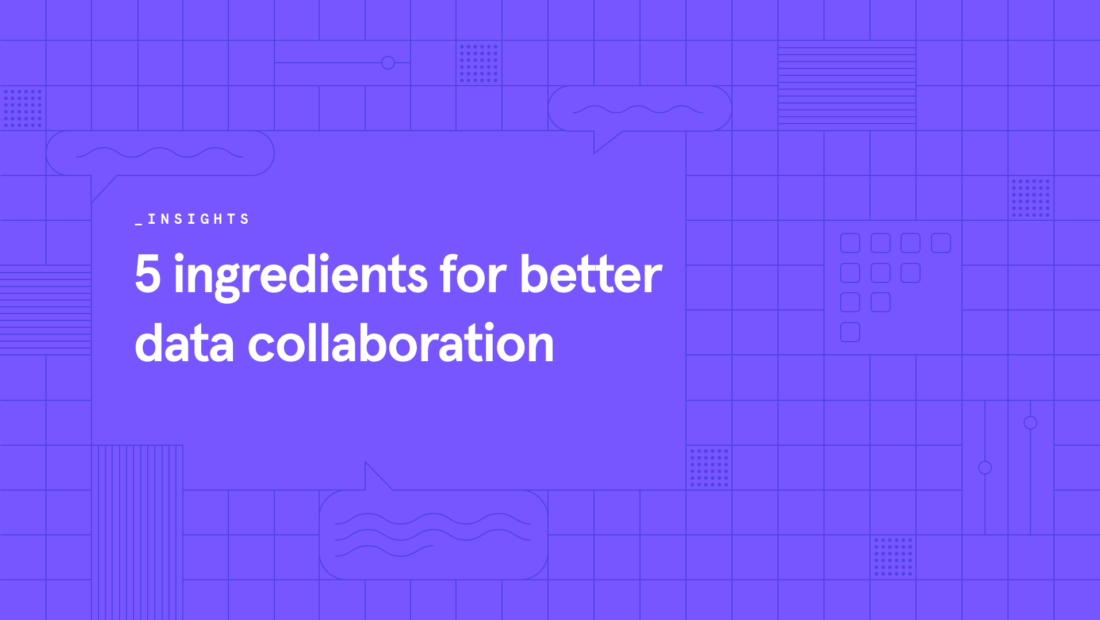
5 ingredients for better data collaboration

When it comes to the four pillars of product analytics maturity, collaboration is the part we on Mixpanel’s Customer Success team are asked about the most: “How can we improve our collaboration?” “How do we improve data sharing between teams?” “How do we create a data culture?”
While the answers to these kinds of questions aren’t simple, we have learned plenty about it all after years of helping all manner of companies get their product analytics strategies up and running. To pass along some of it, here are five areas that we think are super important for building a data culture within your organization—no matter what stage you are in.
Central data source
Where does your data live? How many sources of information do you have?
The biggest blocker we have found within organizations is that even if they have an integrated data stack, with data being collected at every stage of the customer journey, end users throughout the organization (product managers, marketers, executives, etc) still struggle to easily gain access to critical insights they need because the data is siloed or too complex.
The best organizations have a single source of truth—or what you could call a central data reference point or central source of data—where users can easily understand what their data means and where it comes from. Whether that’s screenshots from your app/website showing where events are triggered or a text document, the one thing they all have in common is that this “source of truth” is easy to find, easy to navigate, and empowers the end users to search out and find answers to their own questions.
To centralize data, you can use formal tools such as Confluence or Notion, or you can utilize Lexicon in Mixpanel. Whichever tool you opt for, all your users at every analytics level should know where to find out what events mean and how they can use these events to answer their product questions.
Related: Data democratization in product analytics—and how to get there
Self-serve insights
Another way to up your data collaboration immensely is to embrace self-serve analytics. This means to create a streamlined process for your end users to get answers to their analytics questions as fast as possible, without having to log a ticket with an analyst team or wait for a raw data export from your database—all of which can be extremely time consuming and potentially delay tasks/projects.
Organizations invest in self-serve analytics tools (like Mixpanel) to give their product managers, marketers, and analysts of all levels the ability to access what they need and iterate quickly. But using tools like Mixpanel also lets you give users access to explore and learn about your organization’s data operation in a controlled way, meaning they can create dashboards and charts and experiment freely.
Teams that work closely with data are at their best when everyone is empowered to investigate and question the data for themselves.
Complex analysis
Now that your teams are running analysis for themselves, your high-level analysts and data science team are free to conduct long-term analysis and answer complex statistical questions.
This may require additional tools (Tableau, Looker, etc) or simply a raw data export, but the teams are now able to support the organization in whatever tasks are required by not needing to constantly answer “simple” requests.
Although, complex analysis does not need to be completely separate from self-serve insights. Product managers, marketers, and other data users should be empowered to at least begin learning what increasingly complex questions are worth asking, too. Self-serve analytics can be a gateway for creating a team full of high-level analysts.
Related: What does it take to be a good product analyst? (No, it’s not a data science degree.)
Continuous learning
The biggest mistake an organization can make is to stop learning and iterating. Once your users are able to get the answers they need, they need to be able to push themselves further as needs evolve and data requirements and analysis become more complex.
Data should be at the center of product development and other critical business decisions, meaning all users should have data as part of their everyday role.
The tools you use for analysis should be included as part of a new teammate onboarding and should be refreshed periodically to ensure knowledge is retained and extended.
Not all product managers want to be data scientists, but all product managers should know where to find their data and how to answer questions about their product using data, and those who want to move further with their research or analysis should be encouraged to do so.
Company-wide buy-in
With individual users finding the insights they need and data teams running complex analyses to deliver value and insights, you can now focus on achieving company-wide buy-in and putting data at the heart of your organization.
Start by focusing on teams and individuals who are maximizing their use of data. Highlight what they are doing well to the widest possible audience. Companies should always celebrate their wins, but if you can show how the win was achieved, with numbers backing it up, it becomes far more powerful. Here at Mixpanel when we close a product gap, we have things like ARR numbers attached so that even the perceived “small” changes have tangible impact and are celebrated across the company.
From here, the work of these teams or users can be duplicated across other teams. Their insight and usage can be shared to ensure everyone is working in the same way.
By amplifying the good work you are doing with data, you can highlight how important it is to the entire company. You can justify the spend on tools such as Mixpanel and ensure that the proper investment is made into any additional tools you might need to enhance your data stack and create more sources of data.
This final stage is perhaps the most difficult, and it’s one that can change over time and with changes in more senior positions within the company. However, by focusing on delivering insights and value using the other four focus areas above, you can push for the buy-in required to turn a data-driven team (or teams) into a company-wide data culture.
Final words
All of the points we just went over may read like a list, but your specific journey to creating or improving your data culture could have a slightly different arrangement. Think about which of these five stages you are already doing well. Now think about which areas you need to improve and what has to happen to get that done. Who needs access to the data you are collecting, and do you have tools and processes in place to provide that data? If you can answer all of those, you are already well on your way to putting data at the center of your company and building your data culture.
Gain insights into how best to convert, engage, and retain your users with Mixpanel’s powerful product analytics. Try it free.





